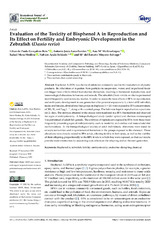Mostrar el registro sencillo del ítem
Evaluation of the Toxicity of Bisphenol A in Reproduction and Its Effect on Fertility and Embryonic Development in the Zebrafish (Danio rerio)
| dc.contributor.author | Gonçalves Reis, Lilian de Paula | |
| dc.contributor.author | Lora Benítez, Antonio | |
| dc.contributor.author | Molina López, Ana María | |
| dc.contributor.author | Mora Medina, Rafael | |
| dc.contributor.author | Ayala Soldado, Nahúm | |
| dc.contributor.author | Moyano Salvago, M. Rosario | |
| dc.date.accessioned | 2022-01-17T17:55:58Z | |
| dc.date.available | 2022-01-17T17:55:58Z | |
| dc.date.issued | 2022 | |
| dc.identifier.uri | http://hdl.handle.net/10396/22343 | |
| dc.description.abstract | Bisphenol A (BPA) is a chemical substance commonly used in the manufacture of plastic products. Its inhalation or ingestion from particles in suspension, water, and/or polluted foods can trigger toxic effects related to endocrine disruption, resulting in hormonal, reproduction, and immunological alterations in humans and animals. The zebrafish (Danio rerio) is an ideal experimental model frequently used in toxicity studies. In order to assess the toxic effects of BPA on reproduction and embryonic development in one generation after parental exposure to it, a total of 80 zebrafish, males and females, divided into four groups in duplicate (n = 20) were exposed to BPA concentrations of 500, 50, and 5 µg L−1, along with a control group. The fish were kept in reproduction aquariums for 21 days. The embryos obtained in the crosses were incubated in a BPA-free medium and observed for signs of embryotoxicity. A histopathological study (under optical and electron microscopes) was performed of adult fish gonads. The embryos of reproducers exposed to BPA were those most frequently presenting signs of embryotoxicity, such as mortality and cardiac and musculoskeletal malformations. In the histopathological studies of adult individuals, alterations were found in ovocyte maturation and in spermatazoid formation in the groups exposed to the chemical. Those alterations were directly related to BPA action, affecting fertility in both sexes, as well as the viability of their offspring, proportionally to the BPA levels to which they were exposed, so that our results provide more information by associating toxic effects on the offspring and on the next generation. | es_ES |
| dc.format.mimetype | application/pdf | es_ES |
| dc.language.iso | eng | es_ES |
| dc.publisher | MDPI | es_ES |
| dc.rights | https://creativecommons.org/licenses/by/4.0/ | es_ES |
| dc.source | International Journal of Environmental Research and Public Health 19(2), 962 (2022) | es_ES |
| dc.subject | Bisphenol A | es_ES |
| dc.subject | Zebrafish | es_ES |
| dc.subject | Fertility | es_ES |
| dc.subject | Embryotoxicity | es_ES |
| dc.subject | Endocrine-disrupting chemical | es_ES |
| dc.title | Evaluation of the Toxicity of Bisphenol A in Reproduction and Its Effect on Fertility and Embryonic Development in the Zebrafish (Danio rerio) | es_ES |
| dc.type | info:eu-repo/semantics/article | es_ES |
| dc.relation.publisherversion | https://doi.org/10.3390/ijerph19020962 | es_ES |
| dc.relation.projectID | Junta de Andalucía. P09-AGR-5143 | es_ES |
| dc.rights.accessRights | info:eu-repo/semantics/openAccess | es_ES |

